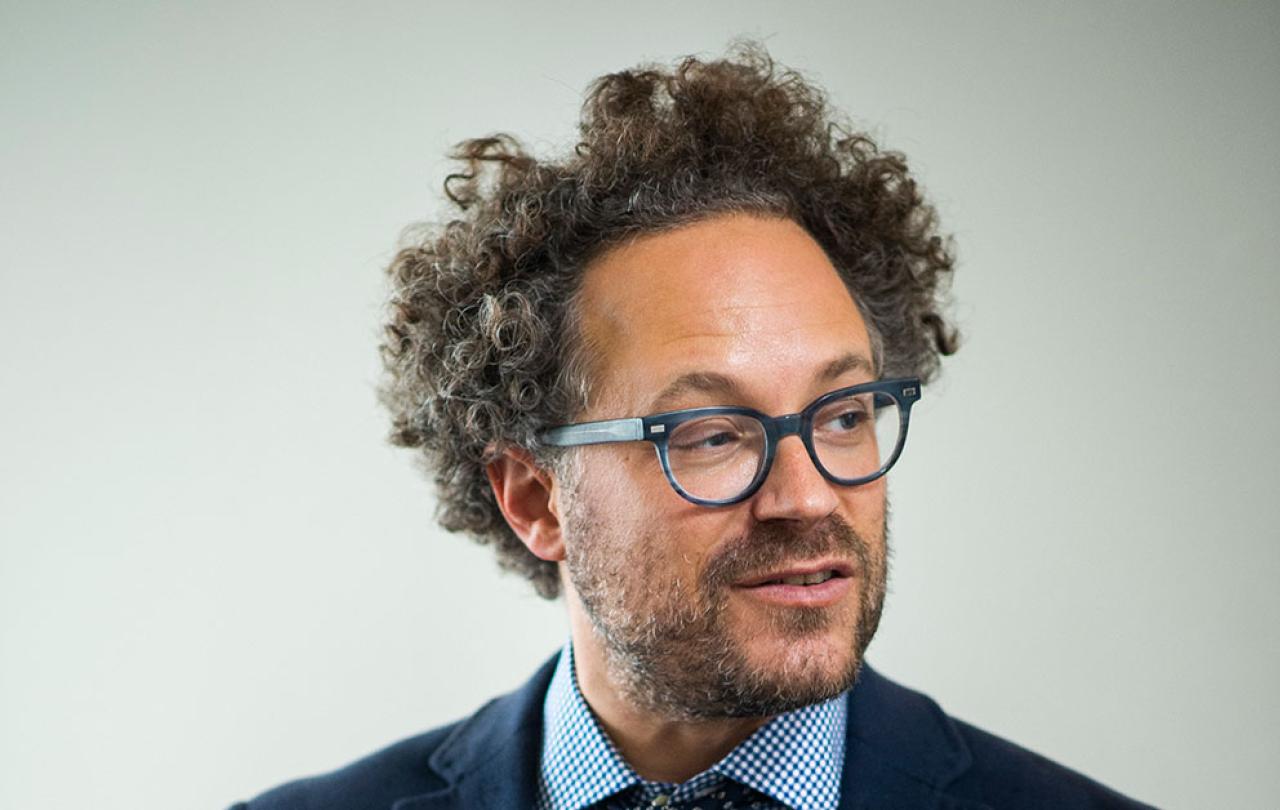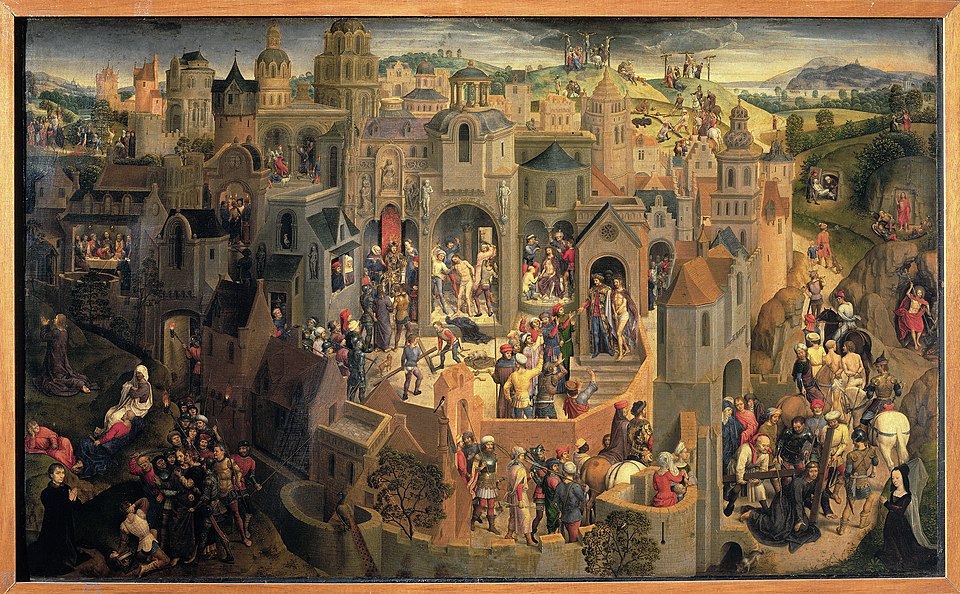
As a writer, curator, and non-profit leader, Aaron Rosen is respected internationally for his work in the public humanities, interfaith dialogue, and the visual arts. With his book What Would Jesus See: Ways of Looking at a Disorienting World he brings a fresh lens to the Gospels, informed by his varied experiences, as well as his life as a practicing Jew married to an Episcopal priest.
He began his career teaching at Yale, Oxford, and Columbia Universities, before becoming Senior Lecturer of Sacred Traditions and the Arts at Kings College London and Professor of Religion & Visual Culture and Director of the Henry Luce III Center for the Arts & Religion at Wesley Theological Seminary, Washington, DC. Currently, as Executive Director of The Clemente Course in the Humanities, a national non-profit in the US, he is involved in delivering transformative, free college courses to low-income adults.
Having particular expertise in art and religion, he has also curated dozens of exhibitions around the world, including an international Stations of the Cross initiative. Together with his wife, Revd Dr Carolyn Rosen, he is founding director of the not-for-profit Parsonage Gallery in Maine which explores ecology and spirituality. He is also arts editor for Image Journal and author or editor of a dozen books including Art and Religion in the 21st Century, Imagining Jewish Art, and Brushes with Faith.
These varied and, in many cases, boundary-crossing experiences have led Aaron to a range of interesting perspectives on the question of Jesus as a visual thinker. Interfaith dialogue features significantly in his experiences and has necessarily been part of his relationship with Carolyn. He thinks the seeds of What Would Jesus See are found in aspects of the journey they have been on together:
‘I always joke that when my wife married a Jew, she converted from Catholicism---just not to Judaism. A bit more accurately, after we were married, Carolyn was received into the Church of England by an Anglican priest, Rev Edward Bailey, a sociologist who had presided over our interfaith wedding. So interfaith dialogue was a part of our relationship, and Carolyn's spiritual journey, early on. Once Carolyn became an Anglican/Episcopalian, the opportunity to become a priest opened up in a way that of course wouldn't be possible in Catholicism. From the moment Carolyn could become a priest, in my mind she started to become one.
I say in my perspective because there was still a whole period in which she had to prove herself to the church. I never doubted she would make an amazing priest, but she had to overcome a lot of obstacles. Perhaps the most egregious was when a priest assigned to guide her in the process told her that she doubted Carolyn's commitment to Christ--and especially mission--because she had married a Jew, and still not managed to convert him! The same priest came to our house to interview us together, and proceeded to tell me that she knew a lot about Jews, including how "they celebrate Passover every week." Needless to say, this person was not exactly an expert in interreligious dialogue! But Carolyn and I stuck it out together and she was able to move forward in the process. In an unlikely turn of events, I found myself as a Jew advocating to Christians why my wife was the ideal ambassador for Jesus! Telling this story, I think the seeds of the current book were sown then, even if I didn't realize it.’
‘I was at the art fairs in New York City this fall and people asked me about my latest book, some people were rather gobsmacked I'd written a book about Jesus!’
With What Would Jesus See, Aaron is participating in a long tradition of what Susannah Heschel has called ‘reversing the gaze’ i.e. Jews (including artists) looking at Jesus in order to provide an unexpected window on identity. I asked him what he has gained personally from being part of this tradition and how he has been able to open up those insights more broadly:
‘I do see myself within a surprisingly long tradition of Jews looking at Jesus, and often quite sympathetically. Many people might expect that Jewish artists, writers, and theologians would simply reject Jesus since--whether he intended to or not, and indeed probably not--he led to the founding of Christianity. But Jewish thinkers and creatives have actually been obsessed for centuries with exploring Jesus' identity as a Jew, often casting him as a sort of role model, whether ethically or creatively. As a scholar of art and religion, I often return to the example of Marc Chagall, who felt deeply in the most traumatic points in his life that only Jesus could really understand or symbolize his anguish as a Jew and an artist; a feeling which gave birth to Chagall's masterpiece, The White Crucifixion. When I set out to write this book, I wanted to introduce and participate within this tradition of imagining a Jewish Jesus. And I wanted to do so in a way that could speak to Jewish and Christian audiences, but also those who stand outside of those traditions.’
He ends the book by saying that, in its writing, he had been surprised by the unpredictable and subversive nature of Jesus. Interestingly, the book’s reception has also revealed ‘that Jesus is more subversive in some contexts than others’, as when ‘I was at the art fairs in New York City this fall and people asked me about my latest book, some people were rather gobsmacked I'd written a book about Jesus!’
As a result, he's not getting us to look at Jesus so much as to look with Jesus. For today's generation of visual thinkers this is an approach that may resonate strongly.
We discussed some of the underpinning approaches he has utilised in writing and structuring the book including ‘reception exegesis’ and ‘relating the given to the found’. I asked what he meant by reception exegesis and how it impacts the way he explores the Gospels:
‘I have always been fascinated by primary texts and images. So, I have a sort of canonical impulse, you might say. But one of the dynamics that interests me most about canonical materials is that they refuse to remain static and contained. They imprint themselves constantly on new communities, and of course have their meanings changed dynamically in that process. When it comes to the Gospels, I am interested not only in how these scriptural texts speak to us, but how they do so through the prism of reception. For example, the great painter Caravaggio left such a powerful imprint on our imagination, it's hard to visualize the story of the calling of St Matthew without thinking of Caravaggio. And then even Caravaggio's images have themselves been reinterpreted again and again, quite interestingly, for example, by contemporary artists from minority communities. So, the process is never-ending and recursive. I certainly don't offer a survey in my book--there are plenty of great commentaries that do--but my readings are informed by such histories of interpretation. Recalling your earlier question, I am probably helped in this process by the interpretive freedom that comes from being a Jew. I am far less burdened by policing 'original' or dogmatically correct meanings of the New Testament than some Christian writers.’
Regarding relating the given to the found, he said he needed to give credit ‘to a dear friend and one of my favourite Christian theologians, Ben Quash, who wrote a book called Found Theology’. A key insight from this book is found where Quash writes, “In God, human beings are constantly invited to relate the given to the found”. Quash then elaborates further: “The givens come alive only in this indefinitely extended series of encounters with new circumstances, and the Christian assumption ought to be that no newfound thing need be construed as a threat to what has been given, for we have to do with the same God both in the given and in the found."
Aaron loves this insight ‘because it takes the ground away from the kind of conservative Christianity I often encountered growing up in America, which was animated by a fear of what was new, and the assumption that it was somehow anti-Christian’. He says: ‘Ben invites us to look instead at how new realities can instead propel Christians back to earlier revelations. I also think that Jesus himself was open to this process. With a Christian theological lens, one might say he finds the very realities which he himself gave the world as its creator. Now of course as a Jew I don't personally see Christ as that ultimate or first giver, so to speak, but I appreciate the beauty and productivity of this kind of Christian thinking.’
In the book, Aaron applies Jesus's unique ways of seeing the world to key challenges facing society today and, as he does so, utilises a fascinating breadth of examples drawn from his varied experience. These include art (such as the example of Chagall), current events (where he looks at transgender issues, among others), and popular culture (including #LogInYourEye). His invitation to his readers is to use their own imaginations to explore with him how Jesus saw, what he saw, and why that is important for us today. Among the aspects he examines are Jesus's eye for spectacle, his strategies for attentiveness, and his tools for discerning truth amid the flurry of false appearances.
He argues that the way Jesus looks at people and the world is radically different because, “Few people in the history of the world have understood as clearly and intuitively as Jesus that the way we look at people is intimately entwined with how we treat them”. He suggests that paying attention, discerning truth, and recognizing others summarize the vision of Jesus – “At the core of his short ministry was a recurring call to look at the world — and especially its most disadvantaged denizens — with new eyes”. As a result, he's not getting us to look at Jesus so much as to look with Jesus. For today's generation of visual thinkers this is an approach that may resonate strongly.
There are some people and communities of course who are exemplifying admirable empathy. But there are so many groups who simply cannot conceive of suffering except on their own 'side.'
He summarises these aspects of the book as follows:
‘In the book, I suggest that there are three main ways in which Jesus invites us to practice looking: with attention, discernment, and recognition. I certainly accept there might be other ways of approaching the topic, but to me these categories help capture the primary ways in which Jesus looks at his world and especially the people in it. I'm probably not spoiling the plot if I say that Jesus certainly attends to every aspect of sight with a spiritual proclivity (does he do anything that isn't spiritually inclined?).’
In the chapter on ‘Paying Attention’ he notes Simone Weil’s suggestion that paying attention to the present moment - in ways similar to that of Jesus and the creative experience of artists and poets - equates to prayer. He also notes in the book that “This emphasis on attentiveness, and its myriad challenges, runs through non-Western religions as well” as “Buddhism, Hinduism, and Jainism are replete with stories that affirm the importance of mindful contemplation”. Since publishing the book, he has found himself continuing to reflect on some of the questions he raises, and that's been especially true of the chapter on paying attention:
‘Recently, I've learned more about collectives and organizations specifically devoted to increasing and refining our dulled capacity for attention, like the Strother School of Radical Attention, whose faculty are especially attuned to the intersection between spirituality and creativity. I've also witnessed the power of prayerful attention in my work leading The Clemente Course in the Humanities. When I was sitting in on one of our courses in Harlem the other day, it struck me just how closely students listened to one another as they read their creative writing assignments. Not just because they were being polite or wanted good grades. They understood the spiritual importance of listening, and creating a space for their peers to reveal deeper truths.’
At the heart of Jesus's ministry, Aaron suggests, is a call to look at our world--especially those who are most disadvantaged--with radical empathy. He suggests that we are living in a time when our eyes have grown weary and unfocused, and, perhaps surprisingly, Jesus offers us the chance to see the world with renewed vision, focused particularly on those who need us most. As a result, he asks us to imagine what Jesus would see if he looked at the world around us today.
With that in mind, I asked why it is so essential in the exceptional times in which we live to highlight the way Jesus’s vision provides strategies for radical empathy:
‘It's hard to see anything happening right now in the world and not think it would benefit from deeper more energetic empathy! Right now, the world is riven by so many disturbing, tragic conflicts, but the one that seems to divide the most people and communities is the Israel-Hamas conflict. There are some people and communities of course who are exemplifying admirable empathy. But there are so many groups who simply cannot conceive of suffering except on their own 'side.' Now I want to be very careful not to suggest that Jesus is somehow the answer to everything that ails society, especially in a complex conflict involving multiple religions and cultures. But certainly some of his tactics, like taking time to pause, look, and deliberate, would be beneficial to all.’
Aaron Rosen, What Would Jesus See: Ways of Looking at a Disorienting World, Broadleaf Books, 2023.






